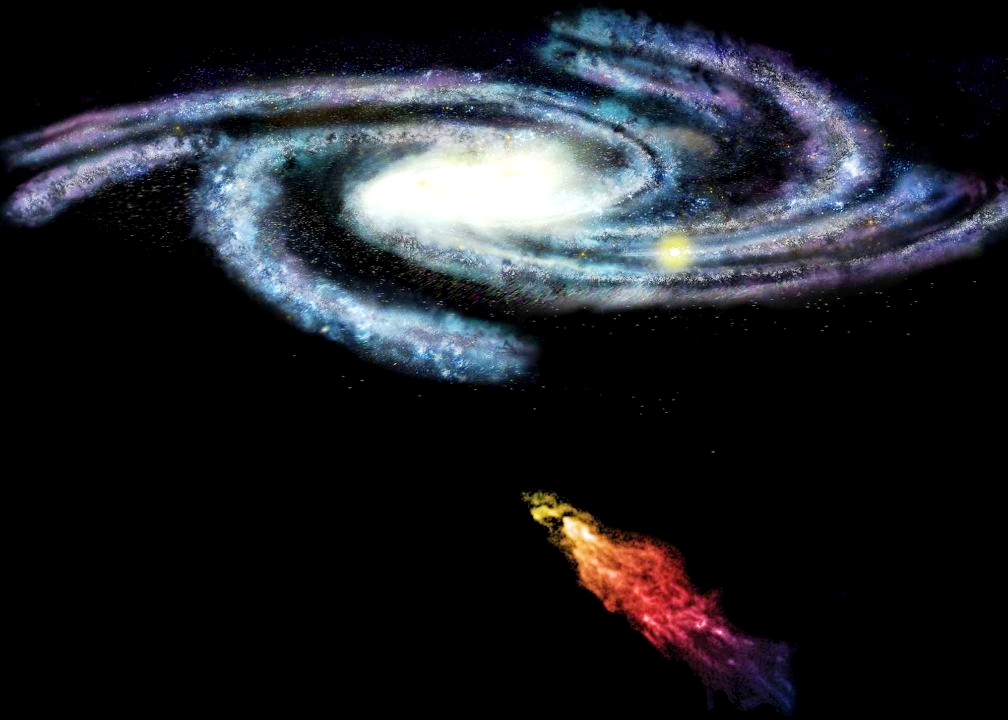Something exciting is happening in space. Astronomers have found a fast-moving cloud near our Milky Way galaxy. This cloud is very unusual. Scientists think it could be a “dark galaxy.”
A dark galaxy is a galaxy that has very few or no stars. This new finding could be the first time we’ve found a dark galaxy close to us. It gives us a chance to learn more about dark matter. Dark matter is a mysterious substance. It makes up most of the universe.
These fast-moving clouds are called high-velocity clouds, or HVCs. They are made of hydrogen gas. They move at speeds that don’t match how the rest of the Milky Way spins. Scientists have wondered for a long time where these clouds come from. Some thought they were gas shot out from our galaxy. Others thought they were left over from when galaxies first formed. It’s been hard to know for sure because it’s difficult to measure how far away they are.
Scientists looked closely at one of these clouds. It is called Complex AC-I. They used powerful radio telescopes. One was the Five-hundred-meter Aperture Spherical Telescope in China. They studied a small, dense part of this cloud, named AC G185.0-11.5.
This gas clump moves in a special way. It spins like a disk. This is different from how most HVCs move. This spinning is a very important clue. It suggests the clump is held together by a strong force.
Think about how galaxies like ours spin. Stars and gas orbit a center. Gravity keeps them together. This gas clump is spinning, but it doesn’t have many stars we can see. This means something invisible must be providing the gravity. Scientists believe this invisible thing is dark matter.
“We found a compact clump within AC-I that exhibits kinematic features resembling a rotating galaxy, dominated by dark matter,” said Ming Zhu, a co-author of the study from the Chinese Academy of Science, Beijing. He told PNAS that this suggests a potential dark galaxy is inside the HVC.
To figure out how much dark matter might be there, scientists estimated the distance to the clump. They used a method that links a galaxy’s spin speed to its normal matter. Their estimate puts the object relatively close to the Milky Way, possibly within our Local Group of galaxies. At this distance, the amount of gas they see is not enough to explain the fast spin. This strongly suggests that a lot of dark matter is present.
“This is the first discovery of a potential dark galaxy in the nearby universe,” astronomer Jin-Long Xu of the Chinese Academy of Sciences in Beijing told Science News.
However, not all scientists are completely sure yet. Tobias Westmeier, another astronomer, told Science News that he thinks it could still be a regular gas cloud. He said more evidence is needed. He noted that it’s hard to tell the difference between a dark galaxy and a gas cloud just falling into the Milky Way if the distance is not exact.
Dark galaxies are a prediction of how galaxies form. Scientists think they might be the smaller pieces that built up bigger galaxies over time. But finding them has been hard. Other possible dark galaxies found before turned out to have some faint stars that were missed at first.
The discovery of AC G185.0-11.5 is exciting because it fits the idea of a dark galaxy so well so far. It moves fast, it’s dense, it has no visible stars, and it spins like a galaxy. Astronomy Magazine highlighted that the clump appears to contain significantly more dark matter than normal matter.
If this object is confirmed to be a dark galaxy, it will be a big deal. It would be a close-up example for studying dark matter. We could learn how dark matter is spread out in a galaxy that is mostly made of it. This could help us understand what dark matter is. It could also help improve our computer models of how galaxies grow and change over billions of years. As PNAS pointed out, astronomers have been looking for these small, compact galaxies for decades.
Scientists are still working on this. They need to make more measurements. They need to find the distance more accurately. They also need even clearer pictures of the clump’s spin.
But even now, this finding is important. It shows us that high-velocity clouds are more interesting than we thought. It keeps the search for dark galaxies going strong. The universe still has many secrets. The idea that a hidden dark galaxy might be right next to us is truly amazing.
